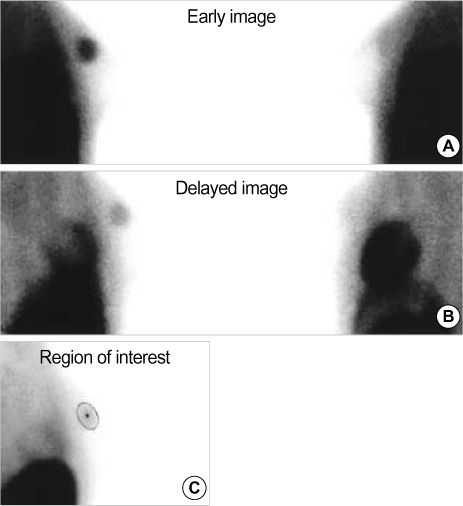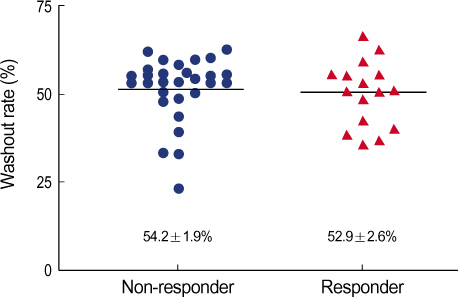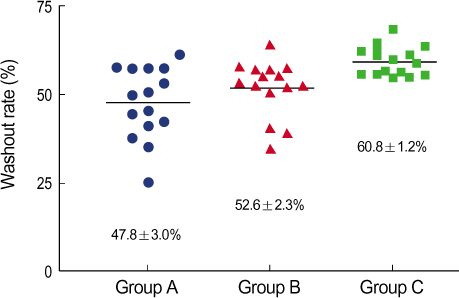J Breast Cancer.
2007 Mar;10(1):29-35. 10.4048/jbc.2007.10.1.29.
The Multidrug Resistance-related Protein and P-glycoprotein Expressions, and the Washout Rates of 99mTc-MIBI in Infiltrating Ductal Carcinoma of Breast, Correlation with the Response After Neoadjuvant Chemotherapy
- Affiliations
-
- 1Department of Surgery, College of Medicine, Pusan National University, Busan, Korea. hskwakmd@pusan.ac.kr
- 2Department of Nuclear Medicine, College of Medicine, Pusan National University, Busan, Korea.
- KMID: 2174998
- DOI: http://doi.org/10.4048/jbc.2007.10.1.29
Abstract
-
PURPOSE: Numerous non-invasive imaging methods for evaluating the chemotherapy response of breast cancer patients are currently being explored. The aim of present study was to investigate whether the washout rates (WRs) of 99mTc-MIBI could predict the response to chemotherapy in patients suffering with infiltrating ductal carcinoma using the expressions of multidrug resistance-related protein (MRP) and P-glycoprotein (Pgp).
METHODS
From May 2002 and March 2004, the patients were randomly and consecutively selected according to the results of immunohistochemical analyses of breast carcinoma specimens before the administration of neoadjuvant chemotherapy. A total 45 infiltrating ductal carcinomas in 45 female patients were selected and they were separated into three groups: group A consisted of tumors with both negative Pgp and MRP expressions (n=15); group B consisted of the tumors that were positive for either a Pgp expression or a MRP expression (n=15); group C consisted of the tumors that were positive for both Pgp and MRP expressions (n=15). All the patients were referred for double phase 99mTc-MIBI mammoscintigraphy after the injection of 925 MBq of 99mTc-MIBI to calculate the WR. The tumor response was evaluated after completion of neoadjuvant chemotherapy. The tumor response was classified as a complete or partial response (the responder group) and stable or progression (the non-responder group). All the patients underwent surgery.
RESULTS
The response rate of group C was lower than that of the other groups, but the difference was not statistically significant (p=0.283). The WR of non-responder group was lower than that of the responder group, although the difference was not statistically significant (p=0.674). The washout rates of group C was the highest than other groups and the difference was statistically significant (p=0.001).
CONCLUSION
In conclusion, the WR of 99mTc-MIBI is helpful for in vivo determination of both the Pgp and MRP expressions for infiltrating ductal carcinoma of the breast.
MeSH Terms
Figure
Reference
-
1. Wolmark N, Wang J, Mamounas E, Bryant J, Fisher B. Preoperative chemotherapy in patients with operable breast cancer: nine-year results from National Surgical Adjuvant Breast and Bowel Project B-18. J Natl Cancer Inst Monogr. 2001. 30:96–102.
Article2. Endicott JA, Ling V. The biochemistry of P-glycoprotein-mediated multidrug resistance. Annu Rev Biochem. 1989. 58:137–171.
Article3. Dexter DW, Reddy RK, Geles KG, Bansal S, Myint MA, Rogakto A, et al. Quantitative reverse transcriptase-polymerase chain reaction measured expression of MDR1 and MRP in primary breast carcinoma. Clin Cancer Res. 1998. 4:1533–1542.4. Filipits M, Suchomel RW, Dekan G, Haider K, Valdimarsson G, Depisch D, et al. MRP and MDR1 gene expression in primary breast carcinomas. Clin Cancer Res. 1996. 2:1231–1237.5. Ito K, Fujimori M, Nakata S, Hama Y, Shingu K, Kobayashi S, et al. Clinical significance of the increased multidrug resistance-associated protein (MRP) gene expression in patients with primary breast cancer. Oncol Res. 1998. 10:99–109.6. Nooter K, Westerman AM, Flens MJ, Zaman GJ, Scheper RJ, van Wingerden KE, et al. Expression of the multidrug resistance-associated protein (MRP) gene in human cancers. Clin Cancer Res. 1995. 1:1301–1310.7. Fojo AT, Ueda K, Slamon DJ, Poplack DG, Gottesman MM, Pastan I. Expression of a multidrug-resistance gene in human tumors and tissues. Proc Natl Acad Sci USA. 1987. 84:265–269.
Article8. Seok JW, Kim SJ, Kwak HS, Lee JW, Kim IJ, Kim YK, et al. Comparison of Ultraound with 99mTc-MIBI scintimammography in the detection of breast cancer. Kor J Nucl Med. 2002. 36:177–184.9. Kim SJ, Kim IJ, Bae YT, Kim YK, Kim DS. Incremental diagnostic value of quantitative analysis of double phase Tc-99m MIBI scintimammography for the detection of primary breast cancer additive to visual analysis. Breast Cancer Res Treat. 2004. 83:129–138.
Article10. Chiu ML, Kronauge JF, Piwnica-Worms D. Effect of mitochondrial and plasma membrane potentials on accumulation of hexakis (2-methoxyisobutylisonitrile) technetium (I) in cultured mouse fibroblasts. J Nucl Med. 1990. 31:1646–1653.11. Piwnica-Worms D, Chiu ML, Budding M, Kronauge JF, Kramer RA, Croop JM. Functional imaging of multidrug-resistant P-glycoprotein with an organotechnetium complex. Cancer Res. 1993. 53:977–984.12. Miller AB, Hoogstraten B, Staquet M, Winkler A. Reporting results of cancer treatment. Cancer. 1981. 47:207–214.
Article13. Podreka I, Suess E, Goldenberg G, Steiner M, Brucke T, Muller C, et al. Initial experience with technetium-99m HM-PAO brain SPECT. J Nucl Med. 1987. 28:1657–1666.14. Rao VV, Chiu ML, Kronauge JF, Piwnica-Worms D. Expression of recombinant human multidrug resistance P-glycoprotein in insect cells confers decreased accumulation of technetium-99m-sestamibi. J Nucl Med. 1994. 35:510–515.15. Liu TJ, Shiau YC, Tsai SC, Wang JJ, Ho ST, Kao A. Predicting multidrug resistance-related protein and P-glycoprotein expression with technetium-99m tetrofosmin mammoscintigraphy. Breast. 2003. 12:58–62.
Article16. Larkin A, O'Driscoll L, Kennedy S, Purcell R, Moran E, Crown J, et al. Investigation of MRP-1 protein and MDR-1 P-glycoprotein expression in invasive breast cancer: a prognostic study. Int J Cancer. 2004. 112:286–294.
Article17. Kostakoglu L, Kiratli P, Ruacan S, Hayran M, Emri S, Ergun EL, et al. Association of tumor washout rates and accumulation of technetium-99m-MIBI with expression of P-glycoprotein in lung cancer. J Nucl Med. 1998. 39:228–234.18. Peng ZM, Luo J, Wang WB, Wang XH, Chen JH, Lan SM. Predictive value of drug resistance-related genes expression in neoadjuvant chemotherapy in patients with non-small cell lung cancer of stage III. Ai Zheng. 2004. 23:963–967.19. Matsui R, Komori T, Namba R, Shimizu T, Sueyoshi K, Sano K, et al. In vitro uptake and release of Tl-201 and Tc-99m-MIBI in cultured tumor cells and effect of anticancer drug. Radiat Med. 1998. 16:187–194.20. Fuster D, Munoz M, Pavia J, Palacin A, Bellet N, Mateos JJ, et al. Quantified 99mTc-MIBI scintigraphy for predicting chemotherapy response in breast cancer patients: factors that influence the level of 99mTc-MIBI uptake. Nucl Med Commun. 2002. 23:31–38.
Article21. Alonso O, Delgado L, Nunez M, Vargas C, Lopera J, Andruskevicius P, et al. Predictive value of 99mTc sestamibi scintigraphy in the evaluation of doxorubicin based chemotherapy response in patients with advanced breast cancer. Nucl Med Commun. 2002. 23:765–771.
Article22. Ciarmiello A, Del Vecchio S, Silvestro P, Potena MI, Carriero MV, Thomas R, et al. Tumor clearance of technetium 99m-sestamibi as a predictor of response to neoadjuvant chemotherapy for locally advanced breast cancer. J Clin Oncol. 1998. 16:1677–1683.
Article23. Takamura Y, Miyoshi Y, Taguchi T, Noguchi S. Prediction of chemotherapeutic response by Technetium 99m-MIBI scintigraphy in breast carcinoma patients. Cancer. 2001. 92:232–239.
Article
- Full Text Links
- Actions
-
Cited
- CITED
-
- Close
- Share
- Similar articles
-
- A Study for Biological Characteristics of Breast Cancer with Tc-99m MIBI Scintigraphy
- Expression of Multidrug Resistance Gene Product in Laryngeal Squamous Cell Carcinoma
- Comparative Uptake of Tc-99m Sestamibi and Tc-99m Tetrofosmin in Cancer Cells and Tissue Expressing P-Glycoprotein or Multidrug Resistance Associated Protein
- A Study of the Biological Characteristics of Breast Cancer by Using Tc-99m MIBI Scintigraphy
- 99mTc-Tetrofosmin Scintimammography in Suspected Breast Cancer Patients: Comparison with 99mTc-MIBI





